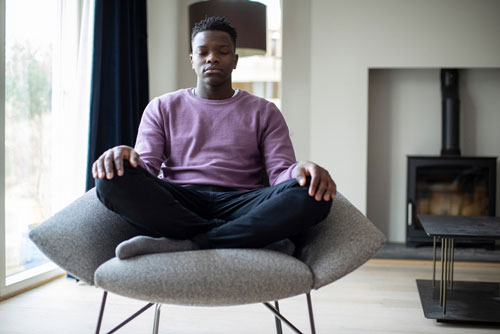Yongey Mingyur Rinpoche is a Buddhist monk. He meditates every day. He has done so since his early teens.
Scientists wondered if it had an impact on his brain. So they took MRI scans.
What they found astounded them.
Rinpoche did not have the brain of someone his age. His brain looked almost 10 years younger.

The study was published in the journal Neurocase. [1]
Researchers from Harvard Medical School and the University of Wisconsin-Madison scanned the Tibetan’s brain with an MRI machine four times over 14 years. During that time, they also scanned the brains of 105 other people who live in the same area. These subjects were about the same age as the monk.
The scientists used an artificial intelligence (AI) system to measure the amount of gray matter in each subject’s brain.
“Gray matter is the neural machinery of the brain,” explained Professor Richard Davidson. He was a senior researcher on the study. “When the brain atrophies, there is a decline in gray matter.”[2]
Gray matter is depleted as people get older.
The AI system estimated that the 41-year-old Rinpoche had the gray matter of someone of someone who was 33. The system found the brains of the other people it analyzed were much closer to their actual ages.
The conclusion? Researchers believe meditation has kept the monk’s brain youthful.
Dr. Kiran Rajneesh is a neurologist who was not involved in the study. He said the monk’s slower brain aging is likely due to the fact that meditation reduces stress. “It kind of makes sense biologically, because stress is a thing that causes aging,” he said. Not just psychological stress, “but also stress happening at the cellular level.”
Step-by-Step Guide to Mindfulness Meditation
Mindfulness is a simple and effective form of meditation. It reduces stress and anxiety, improves attention, relieves depression, and promotes better sleep.[3]
You sit comfortably in any quiet place, focus on your breathing, and when your attention wanders, return.
Here’s a step-by-step guide:
Find a seat. Sit on a chair, a park bench, a carpeted floor—anywhere that is comfortable. You want a stable, solid seat…not a porch swing or rocking chair.
Position your legs. Many people like to cross their legs, but that’s not necessary. Sit so that you can relax.
Sit up. Straighten your upper body, but don’t be stiff. Your back has a natural curve. Let it be there.
Drop your hands. Let your hands rest naturally on your legs.
Look ahead. You can close your eyes or gaze forward without focusing on anything in particular.
Feel your breath. Pay attention to the physical act of breathing. Notice your chest and belly rise and fall. Mentally note breathing in and breathing out.
When your mind wanders… Don’t worry about it. That’s normal. Just go back to paying attention to your breathing.
Stop. Open your eyes if they were closed. Notice how your body feels. Pause for a moment to consider how you’d like to continue on with your day.
As little as five minutes a day is beneficial. But longer sessions—up to a half hour—or two or three sessions a day, work well for many people.
It’s a great way to improve your quality of life while keeping your brain youthful.
Editor’s Note: Discover the single best supplement for stronger immunity… The fruit extract that helps 93% of people with respiratory viruses get better in just two days… The germ hotspot that most of us forget to sanitize. Find all this and more in Independent Healing’s Coronavirus Pandemic Guide. Go HERE.
Related Articles
Meditation Restores Mental Sharpness
Low-Carb Diet Reverses Brain Aging, Study Finds
One Avocado
Does This to Your Brain
Like this Article? Forward this article here or Share on Facebook.
[1]https://www.tandfonline.com/doi/full/10.1080/13554794.2020.1731553
[2]https://allthatsinteresting.com/yongey-mingyur-rinpoche-brain
[3]https://psychcentral.com/blog/10-surprising-health-benefits-of-mindfulness-meditation/

